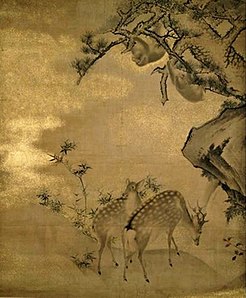
Mori Sosen (森 狙仙, 1747 – August 18, 1821[1]) was a Japanese painter of the Shijō school during the Edo period.
Mori Sosen is famous for his many paintings depicting monkeys. He also painted other animals, such as deers, boars, and peafowl. Robert van Gulik called him "an undisputed master" of the painting of the Japanese macaque. When a gibbon was brought in Japan by the Dutch in 1809, creating somewhat of a sensation (gibbons had long been depicted by Japanese artists, based on Chinese paintings of the animal, but no one in Japan had seen a live gibbon for centuries), it was Mori who had created a graphic record of this event as well.[2]
It is unknown whether he was born in Osaka, Nagasaki, or Nishinomiya, but he lived in Osaka for most of his life.[3]
Gallery
-
Monkeys in a plum tree
-
Apes in a persimmon-tree
-
Monkeys
-
Two monkeys
-
Monkeys playing with a crab
-
Monkeys in a blossoming cherry tree
-
Monkeys in the pines in front of a waterfall
-
Monkeys in the snow
-
Graphic record of the first gibbon imported to Japan.
-
Peacock
-
Painting of a couple of deer, with two monkeys in a tree.
-
Wild boar amidst autumn flowers and grasses
References
- ^ The Great Japan Exhibition: Art of the Edo Period 1600-1868, ISBN 0297780352
- ^ Robert van Gulik, The gibbon in China. An essay in Chinese animal lore. E.J. Brill, Leiden, Holland. (1967). Pages 98-99.
- ^ Tajima, Shi'ichi, ed. (1900). Selected Relics of Japanese Art. Vol. 3. Kyoto: Nippon Bukkyo Shimbi Kyokwai. p. 88.




















